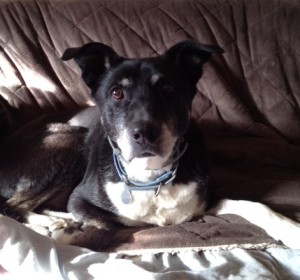Training Tip: Life with a Senior Dog
My girl Sasha is my nearly 14 years old now.
The white muzzle, the greying eyebrows, the cloudy eyes, the deeply sound sleep, the diminished hearing….when did all this happen? It seems only yesterday that she was a 10 week old pup, stealing my heart from a small run in a West Virginia shelter.
My vet marvels at what great shape she’s in, considering her age, and I consider ourselves lucky indeed that Sasha continues to be healthy, alert and agile. She still rules the pack as a benevolent dictator – like the Queen Bee that she is.
Still, we’ve had to make a few adjustments as she has become a senior and some of the things I’ve taught her over our years together have become more important – and more useful – than ever.
Non-verbal signals and situational cues have become our primary means of direct communication, now that she can no longer hear my words very well.
These are a few of the skills I taught her long ago that help us to stay connected to each other in the world we have now:
Non-verbal Signals
Words are great but for a dog with diminished hearing, they aren’t enough. I always teach responses to hand signals and touch, alongside the basic verbal commands.
- An upward sweep of my hand means: “Sit”. A downward sweep means: “Down”.
( These are just the particular movements I use. Your own hand signals can be whatever you care to teach) - The loud clap of my hands, which she hears better than she does my voice, means: “Come to me”.
- My finger, placed gently into the top her collar, means: “Sit”.
- A point of my finger to a specific place means: “Go there”.
- My touch of her flank from behind her means: “Turn around toward me”.
Situational Cues
A situational cue is the result of teaching a dog to have an automatic response in a particular context, without having to rely on a command.
- On walks – whenever I stop, she stops with me. When I move on, she moves with me.
- An open door is not an automatic invitation to go through it. An open door is actually a cue to “Wait and Look At Me”. Then, a sweep of my hand indicates to her that “Yes, you may proceed”.
- When someone comes to the door, Sasha goes to her “Place”.
Spending time training non-verbal and situational cues to your young dog not only builds great skills now, but will reap many rewards when your dog ages, helping to keep your lines of communication open, strengthen your relationship and make life easier for both ends of the leash. For a lifetime.



